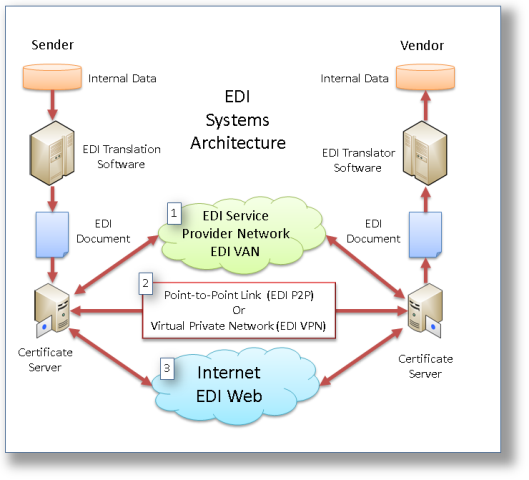Commentary: This post was originally posted 10Mar2011. I have made a few updates then published the post again. EDI is in pervasive use in manufacturing, logistics, banking, and general day-to-day website purchases. Many people have little understanding about EDI. I want to highlight what it is, general implementations, challenges, and benefits.
EDI Overview
by
JT Bogden, PMP
by
JT Bogden, PMP
Electronic Data Interchange, EDI, is the pervasive method of conducting business transactions electronically. It is not technology dependent nor driven by technology implementations. Instead, EDI is driven by business needs and is a standard means for communicating business transactions. The process centers on the notion of a document. This document contains a host of information relating to purchase order, logistics, financial, design, and/or Personal Protected Information (PPI). These informational documents are exchanged between business partners and/or customers conducting business transactions. Traditional methodologies used paper which has a lot of latency in that system and is error prone. Replacing the paper based system and call center systems with electronic systems do not change the processes at all since the standard processes remain independent of the implementation or medium. When the processes are conducted via electronic media the latency is compressed out of the system and errors are reduced making the electronic processing far more desirable given the critical need for speed and accuracy in external processes.
Implementing EDI is a strategy-to-task effort that must be managed well due to some of the complexities of the implementation. A seven step phased process highlights an EDI implementation.
Step 1 - Conduct a strategic review of the business.
Step 2 - Study the internal and external business processes.
Step 3 - Design an EDI solution that supports the strategic structure and serves the business needs
Step 4 - Establish a pilot project with selected business partners.
Step 5 – Flex and test the system
Step 6 - Implement the designed solution across the company
Step 7 - Deploy the EDI system to all business partners
The technology used in EDI varies based on the business strategies, Figure 1. In general, EDI services can operate through three general methods; 1) the Value Added Network (VAN), 2) Virtual Private Network (VPN), 2) by Point-to-Point (P2P), or 30 Web EDI. The first two are for small to medium sized EDI installations where a direct association is known, established, and more secure. Web EDI is conducted through a web browser over the World Wide Web and the simplest form of EDI for vary broad based and low value purchases. The technology in use varies slightly and comes down to three forms of secure communications at a central gateway service such as Secure File Transfer Protocol (FTPS), Hypertext Transport Protocol Secure (HTTPS), or AS2 Protocol which is used almost exclusively by Walmart. Web EDI requires no specialized software to be installed and works across International boundaries well. Web EDI is a hub-and-spoke approach and messages to multiple EDI systems through its gateway service. In addition, industry security organizations provide standards and oversight for data in motion and at rest. PCI Data Security Standards is one such organization.
 |
| Figure 1: EDI Systems Architecture |
Overall, EDI can reduce latency in business transactions and tightly adhere to the organizational strategies without significant adaptation of the organization. Organizations may try to outsource the people, processes, and even the technology as part of their strategy and objectives but processes remain consistent. In conclusion, EDI is a standard that is applied in various forms offering numerous advantages to an organization and business transactions.
No comments :
Post a Comment